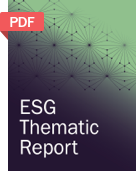Environmental, Social and Governance (ESG) in Luxury Apparel Industry
Contemplating Environmental, Social, and Governance (ESG) within the investment and decision-making processes points to responsible investing. Investment into ESG has been soaring since 2013; equally, Luxury Apparel Industry, have various agenda in achieving certain ESG goals.
Luxury apparel has been widely used for premium customer as those products provides a greater social acceptance. Main ESG factors driving luxury apparel segment are product quality, efficiency of supply chain, affordability, customer satisfaction, toxic chemical usage (dyes), human rights issues from production to retail end and biodiversity impacts.
The companies which are on focus have been significantly scaling up sustainability throughout operations and products, more over innovation and circular procedures have been considered in recent years.
ESG Trends
Luxury apparel theme have impacts on different aspects covering both Social and Environmental aspects. This segment has no compromise for product quality as customers are demanding a greater social status with these apparels.
However, there has been severe drawback on value chain due to which there has been unavailability of those apparels throughout globe. In addition to that large section of society have been boycotting foreign luxury apparels due to various reason like preferring more sustainable home-made apparels or inability to afford due to high import tax. Further, the chemical composition of dyes used in certain products have not been much visible despite the availability of toxic chemical usage policies to ensure least usage of chemicals in the products. Raw materials which are extracted like cotton fiber, silk fiber, jute fiber or any expensive fabric have been produced in a massive scale so there is a significant biodiversityimpact factor. The companies in the luxury apparels segment should also ensure human rights are followed in their operation due to the vast involvement of supply chain.
ESG Challenges
The affordability of the product is a crucial factor as not every social segment can afford these products. Thus, in line with the United Nations’ Sustainable Development Goals (SDGs) such as SDG 10, these companies do not reduce inequalities among minority communities who are unable to afford these products. Also, current market is also witnessing fake products which are destroying the brand value and customer satisfaction as there is improper labelling practices which affects the SDG 16: Peace, Justice, and Strong Institutions. Biodiversityalso plays a vital role in this segment because raw materials like fibers have been prepared out of mass scale plants and animals (cocoon for silk thread) alike, thus impacting SDG 15: Life on Land. Even though human rights issue has been addressed on policies and norms, consumers are preferring hand made products during which making process does have high level of exposure to toxic chemicals and dyes, which in turn can pose damage to the workers which is important to be addressed by these leading companies under SDG 3: Good Health and Wellbeing.
Growth Of Luxury Apparel Market
The global luxury apparel market size to be valued at USD 84.04 billion by 2025 and is expected to grow at a compound annual growth rate (CAGR) of 3.5% during the forecast period. The rising number of millionaires and brand loyalty among customers are anticipated to channelize the growth. Increasing disposable income and consumer spending on luxury products are also predominant factors driving demand for the same.
Key Companies in this theme
• Giorgio Armani
• Burberry
• Dolce & Gabbana
• Prada
• Kate Spade
• Phillip Lim
• PVH Corp. (Calvin Klein).
Scope of the Luxury Apparel Industry ESG Thematic Report:
• Macro-economic and ESG-variable analysis of the industry, including regulatory, policy, and innovation landscape
• Key insights on infrastructure developments and ESG issues affecting the theme
• Identify key initiatives and challenges within the industry
• Identify ESG leaders within the industry
• Understand key initiatives and the impact of companies within the sector to fuel an informed decision-making process
• Analysis of industry activities based on multi-media sources, including significant controversies and market sentiment
Key Benefits of the Luxury Apparel Industry ESG Thematic Report:
• Developing a comprehensive understanding of macro-economic, Policies & Regulations and innovations affecting the luxury apparel space, globally
• Key insights into environmental developments and ESG issues affecting the theme
• Identifying ESG risks and opportunities to business among leading players in the luxury apparel
• Obtaining a clear and relevant understanding of company actions, progress, and impact and find opportunities for investment into the sector.


